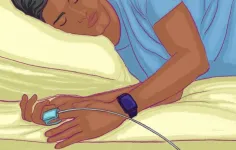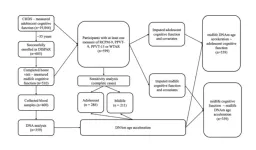(Press-News.org) West Virginia University researchers will put a sleep apnea detection device at the fingertips or wrists of patients facilitating early diagnosis and treatment of the disease with support from a National Science Foundation grant.
Dr. Sunil Sharma, N. Leroy Lapp Professor and division chief of the Pulmonary, Critical Care and Sleep Medicine Fellowship Program in the WVU School of Medicine, received the award after working with other WVU researchers to develop prototypes and secure a patent.
“It’s about taking technology from the lab to the bedside,” Sharma said. “This grant will help us connect with people who have a high level of expertise and join their strengths with ours. We will work with experts in AI, software production and enhancement, industrial production, and technology and hardware enhancement.”
Support from the NSF Innovation Corps program will provide for collaboration among experts from WVU and other institutions.
The prototypes include a watch and a fingertip clip, similar to a pulse oximeter that patients wear while sleeping at home. Both use artificial intelligence technology to measure and analyze data collected via an app on a smartphone or tablet.
“What the devices do is collect information from your bloodstream regarding the certain way the oxygen is delivered and circulated in the blood,” Sharma explained. “Based on those oxygen signals and the algorithms which we have fed in — the way we designed it and calibrated it — they can accurately reflect what may be happening in the body without having to go through very expensive testing.”
Sharma pointed out that results go beyond positive or negative. The technology can also show severity of the disorder, an indicator of whether patients should be treated with continuous positive airway pressure, CPAP, or simple lifestyle changes.
Obstructive sleep apnea, or OSA, is a common condition in which the airways partially or completely collapse resulting in a decrease in oxygen saturation. Although symptoms include loud snoring and excessive daytime sleepiness, many people are asymptomatic. About 80% of OSA cases throughout the world are undiagnosed.
“A delayed diagnosis can lead to worsening of underlying comorbid conditions such as heart failure, stroke and atrial fibrillation because OSA acts like a fuel to other diseases,” Sharma said.
The idea for development of the at-home device follows a five-year study Sharma and colleagues conducted at WVU Medicine J.W. Ruby Memorial Hospital that focused on screening patients hospitalized for general medical and heart failure conditions to determine whether they should be tested further for OSA.
Those who were diagnosed after additional testing received a PAP — positive airway pressure — therapy and were instructed to use it for a minimum of four hours nightly 70% of the time. Assessing patients over six months, researchers found those who were non-adherent to the PAP therapy as prescribed had significantly higher hospital readmissions and emergency room visits for cardiovascular and pulmonary treatment than those who adhered to therapy.
“The above data complimented by similar findings at other institutions strongly suggest that if we catch OSA earlier, the treatment may facilitate in the control of their comorbid conditions,” Sharma said.
The study, published in Journal of Clinical Sleep Medicine, also examined health care spending and hospital resources. Findings show early detection and treatment resulted in lower costs for patients and health care facilities in both the hospital and ambulatory settings. In addition, with fewer people requiring hospitalization, more beds were available for patients with other conditions.
While reasons the disorder goes undetected vary, Sharma said the lack of availability of sleep physicians and sleep lab testing facilities along with low awareness and associated costs to patients play a role.
“Sleep labs are so booked that sometimes it takes weeks to months to get an appointment. In that amount of time, they’re possibly seeing readmission to the hospital and a significant escalation of their condition,” he said.
At-home testing is also more appealing to patients not wanting to spend the night being monitored in an unfamiliar setting, which Sharma said can affect their sleep quality.
The devices may also be of special benefit to people living in rural areas who may have a great distance to travel to a testing site or who need to rely on family members for transportation.
Sharma said he hopes the study raises awareness that early detection of OSA can improve the outcome of patients with comorbid diseases and prevent others from developing more serious conditions.
“We are just learning more and more about this disease, how it drives other conditions and how patients can be very asymptomatic and yet have the disease still going on in their system,” he said. “We do know we can’t treat it if we can’t detect it.”
END
WVU refining at-home sleep apnea detection device to help with more efficient diagnosis, treatment
2024-06-25
ELSE PRESS RELEASES FROM THIS DATE:
UC San Diego receives $5 million to support geriatrics workforce enhancement program
2024-06-25
The University of California San Diego has been selected for the third time to participate in the Geriatrics Workforce Enhancement Program (GWEP). This highly selective program comes with a $5 million grant from the Health Resources and Services Administration (HRSA). These funds will be used over the next five years to support the San Diego Imperial Geriatric Education Center (SDIGEC), which provides geriatric educational programming to health workers and other care providers across both San Diego and ...
Got prunes? Prunes may preserve bone density and strength in older women
2024-06-25
UNIVERSITY PARK, Pa. — Dairy isn’t the only food that’s good for bone health. Prunes may also protect bone structure and strength in postmenopausal women, according to a new study led by Penn State researchers. The findings, published in Osteoporosis International, suggest that daily prune consumption slows the progression of age-related bone loss and reduces the risk of fracture.
“This is the first randomized controlled trial to look at three-dimensional bone outcomes with respect to bone structure, geometry and estimated strength,” said Mary Jane ...
Associations of childhood, adolescence, and midlife cognitive function with DNA methylation age acceleration in midlife
2024-06-25
“[...] our study brings attention to the potential influence of adolescent crystalized intelligence on age-related DNAm at older age.”
BUFFALO, NY- June 25, 2024 – A new research paper was published in Aging (listed by MEDLINE/PubMed as "Aging (Albany NY)" and "Aging-US" by Web of Science) Volume 16, Issue 11, entitled, “Associations of childhood, adolescence, and midlife cognitive function with DNA methylation age acceleration in midlife.”
Prior studies showed increased age acceleration (AgeAccel) is associated with worse cognitive function among ...
Think you might have COVID? Wait two days to test
2024-06-25
Peek in medicine cabinets across the U.S. and you’ll find stacks of leftover COVID-19 tests.
When symptoms arise, so do questions: When should I test? How accurate is it really? And what should I do if I test positive?
In a paper published June 14 in the journal Science Advances, CU Boulder researchers unveil a new mathematical model to quickly answer such questions, not only for COVID but also for emerging rapid tests for respiratory syncytial virus (RSV), the flu and other infectious diseases.
One key takeaway: Advice can differ ...
Researchers develop new training technique that aims to make AI systems less socially biased
2024-06-25
CORVALLIS, Ore. – An Oregon State University doctoral student and researchers at Adobe have created a new, cost-effective training technique for artificial intelligence systems that aims to make them less socially biased.
Eric Slyman of the OSU College of Engineering and the Adobe researchers call the novel method FairDeDup, an abbreviation for fair deduplication. Deduplication means removing redundant information from the data used to train AI systems, which lowers the high computing costs of the training.
Datasets gleaned from the internet often contain biases present in society, the researchers said. When those biases are codified in trained AI models, they can serve to perpetuate ...
Backward walking speed reserve assessment offers improved clinical screening for risks and decline in MS patients
2024-06-25
DETROIT — Wayne State University postdoctoral research fellows Patrick Monaghan, Ph.D., and Michael VanNostrand, Ph.D., along with Nora E. Fritz, Ph.D., PT, DPT, NCS, director of the Neuroimaging and Neurorehabilitation Lab and associate professor of physical therapy in the Department of Health Care Sciences in WSU’s Eugene Applebaum College of Pharmacy and Health Sciences, recently published a study on mobility assessments in the journal, Multiple Sclerosis and Related Disorders.
The study, “Backwards walking speed reserve in persons ...
Clinical trial evaluates economic impact of changing how healthcare is delivered to older people in the emergency department
2024-06-25
The evaluation of the OPTI-MEND trial demonstrates that investing in an additional dedicated professional team to the already existing ED care increases patients’ quality of life and will save, on average per person, a staggering €6,128.
Crowding in emergency departments (EDs) is a growing problem in Ireland and internationally and, coupled with long waiting times, affects healthcare outcomes and patient satisfaction. A new study from researchers at Trinity College Dublin and University of Limerick examined the economic impact of adding a specific, appropriate, and dedicated team of professionals to the care already available ...
Uncovering the drivers of a million-year-old glacial transition
2024-06-25
The climate modeling community has been particularly vexed by the glacial/interglacial cycles of the past three million years, when the Northern Hemisphere oscillated between times with and without large ice sheets.
From about 1.25 million to 750,000 years ago—in the Pleistocene epoch—a change in glacial cycles called the Mid-Pleistocene Transition (MPT) occurred. During this time, glacial/interglacial cycles shifted from occurring every 41,000 years to every 100,000 years, with an increase in the amplitude and asymmetry of the cycles. Scientists are working to understand why these changes happened, considering that insolation forcing—variation ...
Surprising vortex behind new solar cell and lighting materials
2024-06-25
Metal-halide perovskites have quickly advanced in the last decade since their discovery as a semiconductor that outshines silicon in its conversion of light into electric current.
Simulations on TACC's Frontera and Lonestar6 supercomputers have revealed surprising vortex structures in quasiparticles of electrons and atoms, called polarons, which contribute to generating electricity from sunlight.
This new discovery can help scientists develop new solar cells and LED lighting. This type of lighting is hailed as eco-friendly, sustainable technology ...
Should you eat more dietary fiber? New study says it depends.
2024-06-25
ITHACA, N.Y. -- Nutritionists generally advise everyone to eat more dietary fiber, but a new Cornell University study suggests that its effects on health can vary from person to person. The findings indicate that recommendations should be tailored to each individual’s gut microbiome.
The study, published in Gut Microbes, focused on resistant starch, a category of dietary fiber found in such foods as bread, cereals, green bananas, whole-grain pasta, brown rice and potatoes.
The researchers identified ...





